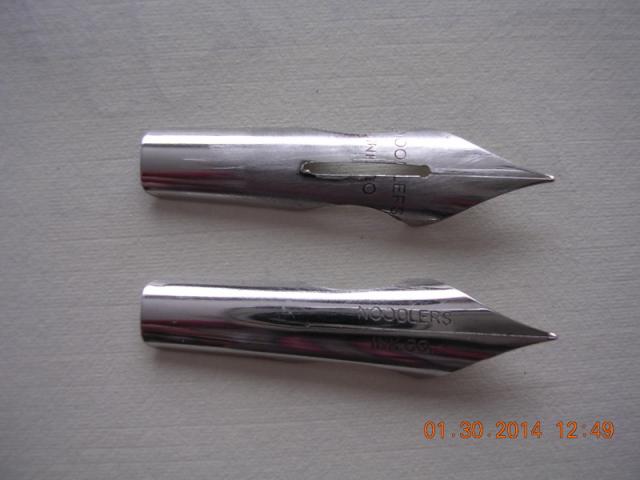Search the Community
Showing results for tags 'nib conversion'.
-

Converting A Regular Nib Into A Flex Nib For Noodler's Ahab/konrad
Brooks MT posted a topic in USA - North America
So there I was. I'd loaned my Ahab to a Martian who needed directions to the White House. He/she/they(?) sneezed, and the Noodlers flex nib dissolved. My pen was out of action! Interplanetary Crisis! Noodler's doesn't sell replacement flex nibs, at least not yet. I had a Noodler's regular fountain pen nib, free gift when I bought my pen. Taking my trusty Dremel, I set out to modify the regular nib to make it into a flex. Fortunately for the Solar System, it worked. In case you ever find yourself in a similar boat, here's what I did. 1) Extend slot of regular nib with Dremel cutoff wheel. 2) Apply Pterodactylus' Ease My Flex (EMF) Mod. 3) Adjust the tines; heat-set the feed if necessary. 4) Clean...and test. Details: 1) I made a jig to position the Dremel cutoff wheel on the nib. Ahab/Konrad nibs have an arc that matches a 1/4" bolt. I used a 1/4" wooden dowel about 1.5" long for the jig. I hand cut a slot in the dowel with a coping saw, trying to keep the slot in the middle of the dowel. Slot length is about 1/2 the diameter of the cutoff wheel. I clamped the dowel vertically in a vice, and ran down the slot with the cutoff wheel to enlarge the slot to fit the wheel. BE SURE TO WEAR A FACE SHIELD whenever using a cutoff wheel. These cutoff wheels can't take any twist, they will shatter. There will be some smoke as the wheel cuts/burns its way down dowel. Stop when the axle of the wheel reaches the top of the dowel. I clamped the nib in a vice, using the dowel and a popsickle stick to protect the nib. See photo. Note, the 2nd bit of dowel in the vice, to the right of the nib, is there to keep the vice jaws from cocking as I tightened the vice. I wanted to extend the slit to match the length of a Noodler flex nib's slit. I marked the approximate stop point on the nib with a black marker pen. I positioned the dowel slot over the center of the Concave side of the nib. By cutting from the concave side, the wheel will have less tendency to wander. Positioning the nib/dowel/vice took some fiddling. My goal was to start the wheel at about the 1/2 way point in the desired slot extention. The cutoff wheel diameter gets smaller as you use it on your projects. You'll have to match the size of your wheel to the middle of the desired slot, I can't give you any precise figures. My wheel was not quite new, so was a few mm smaller in diameter than a new wheel. Take light cuts, removing the wheel to check that the nib is not getting too hot. I dribbled water on the nib periodically, just to be safe. But the nib never felt hot to my fingers, even after the first (dry) cut. The wheel will cut on both sides of the slot since this is a "plunge" cut. I positioned the Dremel so that the wheel would try to climb up the nib; I never had a problem with climbing, though. I used a "medium" speed for the Dremel. After I got the slot length I wanted, I deburred with wetordry sandpaper, and a scraper (small screwdriver blade...the universal tool). Deburring took a while. 2)Once the slot was deburred, I applied the EMF mod. See his thread for details. https://www.fountainpennetwork.com/forum/index.php/topic/240492-noodlers-ahab-ease-my-flex-mod/ 3) I had to adjust the tines, in/out and up/down and rotation. The slotting had spread the tines, and the EMF procedure had warped them a bit. I needed to use round-jaws needle-nose pliers to bend the tines parallel to the arc; this was to correct an "Inverted Grand Canyon slit" problem (Richard Binder terminalogy), probably caused by the slotting operation. Eventually I got the slit and tip looking ok. Richard Binder's Nib Smoothing Workshop notes (.pdf) is a great help in showing you what you need to see at the tip. The nib was not snug against the tip of the feed, so I heat-set the feed to the nib. Nathan Tardif uses a "Tiki oil candle" in his demonstration video. Ace Hardware had similar candles under the "Ultra Pure Liquid Candle" name (on a shelf next to lamp oil and tea candles). This was my first heat-set....I held the feed a little too long above the flame, and the feed started to smoke, oops. The fins expanded a bit, clearly suffering from the heat; but they still will hold ink, fortunately. 4) Clean and clean again with dish soap+ammonia. I also used rubbing alcohol to remove fingerprints & grease from the nib. Testing was long. Initially, the pen would not pass ink past the slot. The ink channel would dry up, under the slot, as I wrote. This drying was exacerbated by the wonderful flex of this nib - wide areas are Very wide, expending ink quickly. Pen would work fine if I covered the slot with a bit of masking tape. This would restore the wicking action needed to move ink past the slot to the slit. I tried various fillers to increase capillary action in the ink channel under the slot: brass wire, cotton threads, stainless steel wire. Cotton thread (from string) laid in the ink channel wetted the best, but flow was still slow. Eventually, repeated cleaning of the feed with a the soapy solution and a test-tube brush, got me back in business. The ink will flow through the ink channel without needing any capillary enhancers or masking tape lid. When I burned the feed, perhaps some of the combustion products were inhibiting ink flow? The pen writes fine now. I can't write at blazing speed, the feed can't keep up. However, for normal calligraphy writing speed, the new nib with slot works well. If I feel the need for speed, I'll just put a small bit of tape over the slot. If it was clear tape, no one would even know :-) Oh yes, Step 5) Always carry a Loaner Pencil in case you run into Martians. The photos: 1) Modified nib and original flex nib. 2) Jig and vice. Slot has been cut, deburring next. 3) Look, it writes! I diluted the ink to get more shading. A 50% dilution, not seen here, works better. Without dilution, my wet lines show no shading with this ink.



